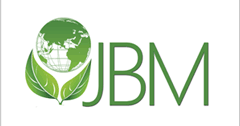About This Journal
Contact Information
All queries related to the journal should be addressed at
jbm.brc@gmail.com .
Address: House Number 1, Street 67, Sector G-6/4, 44000 Islamabad, Islamabad Capital Territory, Pakistan.
The Journal of Bioresource Management (JBM) is an Open Access, Peer-Reviewed International Journal, founded in 2013 and published by Center for Bioresource Research, (CBR ) Islamabad, Pakistan, in collaoration with Wright State University Library, Ohio, USA. JBM offers a fast publication schedule as issues are published quarterly. A paper would normally take about four to six months for processing from the date of submission to its online publication.
Indexing Services
All articles published in JBM are included in:
ZOOLOGICAL RECORDSHERPA/RoMEO
Google Scholar
CORE Scholar
EBSCOhost
VCU LIbrary
Flinders University Library
ERIH Plus
EMBASE
World Cat
Index Copernicus
doaj.org
Aims and Scope
Journal of Bioresource Management publishes original research papers, scientific notes, review articles and case reports on all aspects of bioresources including plants, animals, wildlife, fisheries, birds and their management. Publications in JBM cover a wide ranging research areas of biological sciences such as: agronomy, herpetology, entomology, conservation, ecology, plant nutrition, plant physiology, cell and molecular biology, medical sciences, ethnopharmacology and phytomedicine. Research papers and reviews on eco-friendly sustainable management of bioresources will be given priority. Authors are expected to give new ideas, concepts and principles having more general applications with significant future impact on the issues.
Instructions for Authors
Thank you for choosing to submit your paper to us. These instructions will ensure that we have everything required, so your paper can move through peer review, production and publication smoothly. Please take the time to read and follow these as closely as possible, as doing so will ensure that your paper matches the journal's requirements. The detailed instructions for preparation of manuscript are provided below. For any further information you can contact at
jbm.brc@gmail.com .
Formatting Requirements
- Submit your manuscript, including tables, figures, appendices, etc., after the list of references as a single file (Word, RTF, or PDF files are accepted).
- Do not include page numbers, headers, or footers. These will be added by the editor.
- Page size should be 8.5 x 11-inches.
- All margins (left, right, top and bottom) should be 1.5 inches (3.8 cm), including tables and figures.
- Use a single column layout with both left and right margins justified.
- If figures are included, use high-resolution figures, preferably encoded as encapsulated PostScript (eps).
- Manuscript must be typed in Times New Roman.
Indent all paragraphs except those following a section heading. An indent should be 2 em-spaces. All text should be single spaced. Proof read the manuscript with care. After acceptance press copy of the manuscript will be sent to the authors and the final published version will be responsibility of the authors.
Language and Grammar
All submissions must be in English. Authors should use , standard English grammar, including punctuation. The Elements of Style by William Strunk, Jr. and E. B. White (now in its fourth edition) is the "standard" guide, but other excellent guides (e.g., The Chicago Manual of Style, University of Chicago Press) exist as well.
Article Length
Because this journal publishes electronically, page limits are not as relevant as they are in the world of print publications. We are happy, therefore, to let authors take advantage of this greater "bandwidth" to include material that they might otherwise have to cut to get into a print journal.
Colored text
Set the font color to black for main body of the text. We encourage authors to take advantage of the ability to use color in the production of figures and maps. However, you are advised to avoid the use of colors in situations where their translation to black and white would render the material illegible or incomprehensible.
Emphasized text
Use italics to indicate text you wish to emphasize rather than underlining it. The use of color to emphasize text is discouraged.
Headings
Title and headings of the manuscript should be bold, written in upper case, font size 12pt whereas subheadings should be bold, italicized and written in lower case. There should be space above and below headings.
Main text
Main body of text must be typed in Times New Roman of font size 12pt.
Titles
Titles of books, movies, etc. should be set in italics rather than underlined.
Footnotes
Foot notes must be typed in Times New Roman of font size 10 pt. They should be single spaced, and there should be a footnote separator rule (line).
Tables and Figures
Tables and Figures must be cited in the text and placed at appropriate place in relevance to the text after manuscript is accepted. All tables and figures must fit within 1.5" margins on all sides (top, bottom, left and right) in both portrait and landscape view. Each table and figure should be numbered in Arabic numerals and supplied with a heading and a legend. Same data should not be presented in both table and graphic form or repeated in the text.
Mathematics
Use Roman letters in mathematical expressions and variables should be italicized. Roman letters used as part of multi-letter function names should not be italicized. Whenever possible, subscripts and superscripts should be a smaller font size than the main text. Short mathematical expressions should be typed in-line.Longer expressions, important definitions or concepts should be set as display math.Equations should be numbered sequentially. Whether equation numbers are on the right or left is the choice of the author(s).
Article Structure
The different sections of the paper must be prepared in the following order:
Title
The title should be concise and informative and should not include non-standard acronyms or abbreviations. It should be typed in upper case, 12 point, bold, Times New Roman, single line spacing, centered.
Author Names and Affiliations
Please clearly indicate the given name(s) and family name(s) of each author. The author names should be written in upper case, 10 point, bold, Times New Roman, single line spacing, centered. An asterisk (*) must be placed after the corresponding authors name as superscript. Present the authors' affiliation addresses below the names. Provide the full postal address of each affiliation, including the country name and e-mail address of each author. The author affiliation should be written in sentence case, 10 point, non-bold, italicizes, Times New Roman, single line spacing, centered. Mark the affiliation with the respective numbering in superscripts (1, 2, 3 etc) used in the Authors field.
Abstract
The abstract should be an objective representation of the article and it must include problem of statement, experimental approach, major findings and conclusion. Avoid abbreviations, diagrams and references in the abstract. It should not exceed 250 words.
Key Words
Up to 5 key-words, reflecting the content of the paper should be written immediately below the abstract
Introduction
The introduction should briefly place the study in a broad context, highlighting its importance and brief review of the literature citing only recent references. It should define the purpose of the work and its significance, including specific hypotheses being tested and main objectives of the work.
Material and Methods
This section must contain sufficient details about the materials studied, instruments used, specialized chemicals source and related experimental details which allow other research workers to reproduce the results.
Ethical Approval
Clear statement appearing at appropriate place in Material and Method section about approval from ethical committee of the Institute/organization, indicating that efforts were taken to minimize pain to the animal during experimentation should be mentioned following all internationally accepted animal and/or human research and handling policies and ethics. The specific conditions followed in animal and human handling be also mentioned, like the needle size, sample collected by qualified medical doctor or nurse, etc. Consent of the human volunteers to participate in the study taken, after duly informing them on the purpose of the study and maintenance of the confidentiality and anonymity of the information conveyed in the publication.
Result and Discussion
It may be present as single combined section or split into two separate "Results" and "Discussion" sections. Provide a concise and precise description of the experimental results, their interpretation as well as the experimental conclusions that can be drawn. Discussion should be logical, results oriented in the light of previous literature justifying your findings.
Conclusion
Conclusion can be provided under a separate heading or a short paragraph highlighting the important salient features of study at the end of discussion section.
Acknowledgement
Brief statement, acknowledging financial support and or other assistance received from individuals, institutions or reproduction of published material etc. should be mentioned.
Conflict of Interest
Authors must declare any conflict of interests before publication.
Author’s Contribution
Contribution of each author in the study and/or in drafting the manuscript shall be clearly stated and be responsible for originality of scientific content to be published.
Data Availability Statement (DAS)
Include a “Data Availability Statement (DAS)” in your manuscript before the references section. The DAS should clearly indicate the status of the data used in your study, whether the data are openly available, available upon request, restricted, or if no new data were generated. If applicable, provide the name of the data repository along with its URL or DOI (e.g., [Repository Name] at [URL/DOI] ).This helps improve transparency, supports reproducibility, and aligns your work with open research practices. Acknowledge the funding agncies with grant support details if applicable.
References
Only the absolutely necessary references must be used for the substantiation of the paper. When references are cited in the text, last name of the author and year should be in brackets e.g., (Christopoulos, 1998). If the author’s name is an integral part of the sentence, the date only is placed in brackets e.g., as reported by Christopoulos (1998). In case of two authors, both names must be written (e.g., Christopoulos and Papadopoulos, 1999). For more than two authors, the name of the first author is given followed by «et al., (e.g., Papadopoulos et al., 1999). Where several references are quoted together, they should be placed in chronological order separated by semicolons, whereas references of the same author for the same year are distinguished by the addition of a small letter and A comma ( , ) after the year (e.g. 2000a, 2000b, etc.). At the end of paper the full citations of all references appearing in the text should be listed in alphabetical order of the first author’s last name. Care should be taken that all citations are appropriately listed in the references. References should be set out as follows:
Journal’s article: Author's names (year of publication). Title of article. Journal abbreviation volume: page numbers e.g., Abdullah S, Javed M, Yaqub S, Ahmed N (2011). Metal bioaccumulation pattern in major carps during acute toxicity tests. Int. J. Agric. Biol. 13: 756-760.When no author is named: Anonymous (1989). Early diagnosis in cattle. Vet Rec 96: 24-28.
For supplementary issues of a journal: Kirk RW (1989). Diseases of Dogs and Cats. Small Anim Pract 12 (Suppl): 48-52.
Book: Author's names (year of publication). Title of book. Edition, publisher, publisher's address: Page number. Simeson AB (1980). Calcium phosphorus and magnesium metabolism. In: Clinical Biochemistry of Domestic Animals. 3rd ed, Academic Press, New York: pp 576-586.
Chapters of book: Author's names (year of publication). Chapter of book. Title of book. Edition, publisher, publisher's address: Page number.
Simeson AB (1980). In: Clinical Biochemistry of Domestic Animals. 3rd ed, Academic Press, New York: pp 576-586.
Article Processing Charges
Submission and processing of articles is free of cost.





